Medicinal Case Study: Patient Medication Risks and Education
VerifiedAdded on 2021/02/22
|9
|2234
|124
Case Study
AI Summary
This case study examines the case of a 54-year-old female, Ms. Candice Tong, who presents with upper abdominal pain, vomiting, and nausea, and has a history of hyperlipidaemia, hypertension, and depression. The study focuses on the risks associated with her current medications, including Ramipril, Felodipine, Atorvastatin, and Citalopram. It explores strategies for managing these risks, such as dietary modifications, cognitive behavioral therapy, and lifestyle changes. The analysis also investigates the impact of Ibuprofen and St. John's wort on the patient's prescribed medications and provides key educational points for the patient, emphasizing the importance of medication adherence, diet, exercise, and social support. The study concludes with a summary of the key findings and recommendations for improved patient outcomes, supported by relevant research and clinical observations.
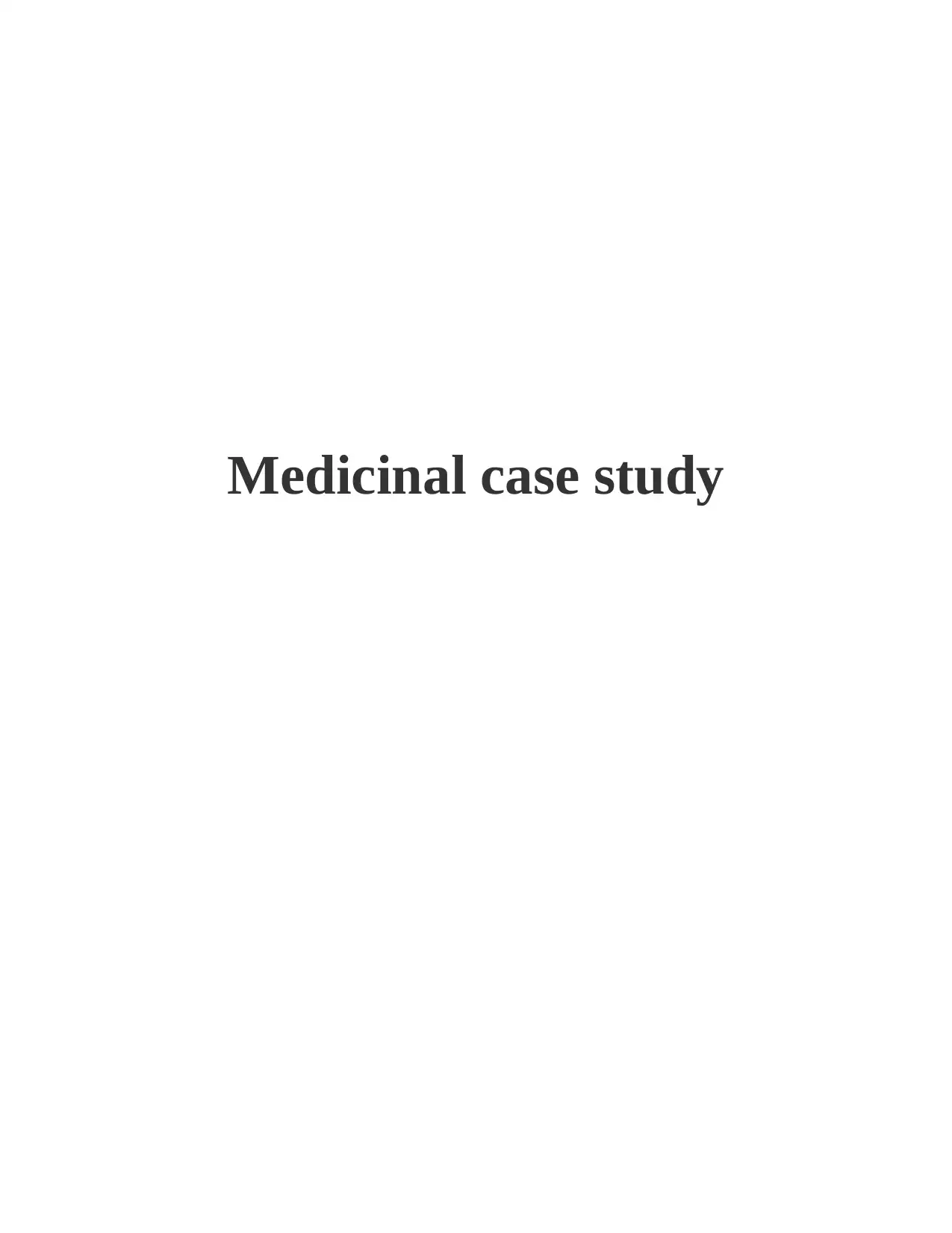
Medicinal case study
Paraphrase This Document
Need a fresh take? Get an instant paraphrase of this document with our AI Paraphraser

Table of Contents
INTRODUCTION...........................................................................................................................3
MAIN BODY...................................................................................................................................3
1. Risk associated with the use of certain medicines...................................................................3
2. Strategies to manage risk associated with the medication.......................................................4
3 (a). Impact of Ibuprofen and St John's wort on the current prescribed medication..................5
3 (b). Key education to the patient...............................................................................................6
CONCLUSION................................................................................................................................6
REFERENCES................................................................................................................................1
INTRODUCTION...........................................................................................................................3
MAIN BODY...................................................................................................................................3
1. Risk associated with the use of certain medicines...................................................................3
2. Strategies to manage risk associated with the medication.......................................................4
3 (a). Impact of Ibuprofen and St John's wort on the current prescribed medication..................5
3 (b). Key education to the patient...............................................................................................6
CONCLUSION................................................................................................................................6
REFERENCES................................................................................................................................1
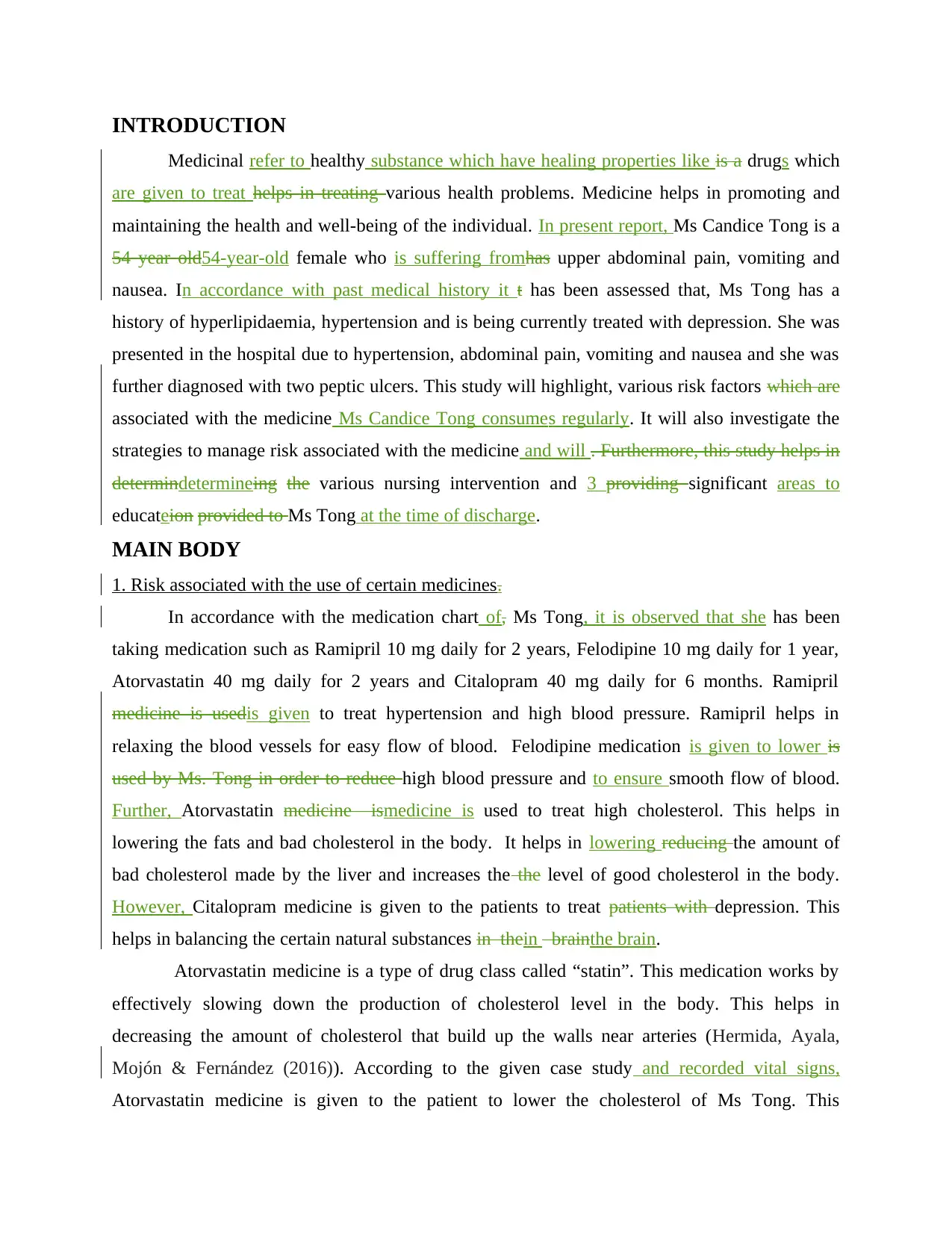
INTRODUCTION
Medicinal refer to healthy substance which have healing properties like is a drugs which
are given to treat helps in treating various health problems. Medicine helps in promoting and
maintaining the health and well-being of the individual. In present report, Ms Candice Tong is a
54 year old54-year-old female who is suffering fromhas upper abdominal pain, vomiting and
nausea. In accordance with past medical history it t has been assessed that, Ms Tong has a
history of hyperlipidaemia, hypertension and is being currently treated with depression. She was
presented in the hospital due to hypertension, abdominal pain, vomiting and nausea and she was
further diagnosed with two peptic ulcers. This study will highlight, various risk factors which are
associated with the medicine Ms Candice Tong consumes regularly. It will also investigate the
strategies to manage risk associated with the medicine and will . Furthermore, this study helps in
determindetermineing the various nursing intervention and 3 providing significant areas to
educateion provided to Ms Tong at the time of discharge.
MAIN BODY
1. Risk associated with the use of certain medicines.
In accordance with the medication chart of, Ms Tong, it is observed that she has been
taking medication such as Ramipril 10 mg daily for 2 years, Felodipine 10 mg daily for 1 year,
Atorvastatin 40 mg daily for 2 years and Citalopram 40 mg daily for 6 months. Ramipril
medicine is usedis given to treat hypertension and high blood pressure. Ramipril helps in
relaxing the blood vessels for easy flow of blood. Felodipine medication is given to lower is
used by Ms. Tong in order to reduce high blood pressure and to ensure smooth flow of blood.
Further, Atorvastatin medicine ismedicine is used to treat high cholesterol. This helps in
lowering the fats and bad cholesterol in the body. It helps in lowering reducing the amount of
bad cholesterol made by the liver and increases the the level of good cholesterol in the body.
However, Citalopram medicine is given to the patients to treat patients with depression. This
helps in balancing the certain natural substances in thein brainthe brain.
Atorvastatin medicine is a type of drug class called “statin”. This medication works by
effectively slowing down the production of cholesterol level in the body. This helps in
decreasing the amount of cholesterol that build up the walls near arteries (Hermida, Ayala,
Mojón & Fernández (2016)). According to the given case study and recorded vital signs,
Atorvastatin medicine is given to the patient to lower the cholesterol of Ms Tong. This
Medicinal refer to healthy substance which have healing properties like is a drugs which
are given to treat helps in treating various health problems. Medicine helps in promoting and
maintaining the health and well-being of the individual. In present report, Ms Candice Tong is a
54 year old54-year-old female who is suffering fromhas upper abdominal pain, vomiting and
nausea. In accordance with past medical history it t has been assessed that, Ms Tong has a
history of hyperlipidaemia, hypertension and is being currently treated with depression. She was
presented in the hospital due to hypertension, abdominal pain, vomiting and nausea and she was
further diagnosed with two peptic ulcers. This study will highlight, various risk factors which are
associated with the medicine Ms Candice Tong consumes regularly. It will also investigate the
strategies to manage risk associated with the medicine and will . Furthermore, this study helps in
determindetermineing the various nursing intervention and 3 providing significant areas to
educateion provided to Ms Tong at the time of discharge.
MAIN BODY
1. Risk associated with the use of certain medicines.
In accordance with the medication chart of, Ms Tong, it is observed that she has been
taking medication such as Ramipril 10 mg daily for 2 years, Felodipine 10 mg daily for 1 year,
Atorvastatin 40 mg daily for 2 years and Citalopram 40 mg daily for 6 months. Ramipril
medicine is usedis given to treat hypertension and high blood pressure. Ramipril helps in
relaxing the blood vessels for easy flow of blood. Felodipine medication is given to lower is
used by Ms. Tong in order to reduce high blood pressure and to ensure smooth flow of blood.
Further, Atorvastatin medicine ismedicine is used to treat high cholesterol. This helps in
lowering the fats and bad cholesterol in the body. It helps in lowering reducing the amount of
bad cholesterol made by the liver and increases the the level of good cholesterol in the body.
However, Citalopram medicine is given to the patients to treat patients with depression. This
helps in balancing the certain natural substances in thein brainthe brain.
Atorvastatin medicine is a type of drug class called “statin”. This medication works by
effectively slowing down the production of cholesterol level in the body. This helps in
decreasing the amount of cholesterol that build up the walls near arteries (Hermida, Ayala,
Mojón & Fernández (2016)). According to the given case study and recorded vital signs,
Atorvastatin medicine is given to the patient to lower the cholesterol of Ms Tong. This
⊘ This is a preview!⊘
Do you want full access?
Subscribe today to unlock all pages.

Trusted by 1+ million students worldwide
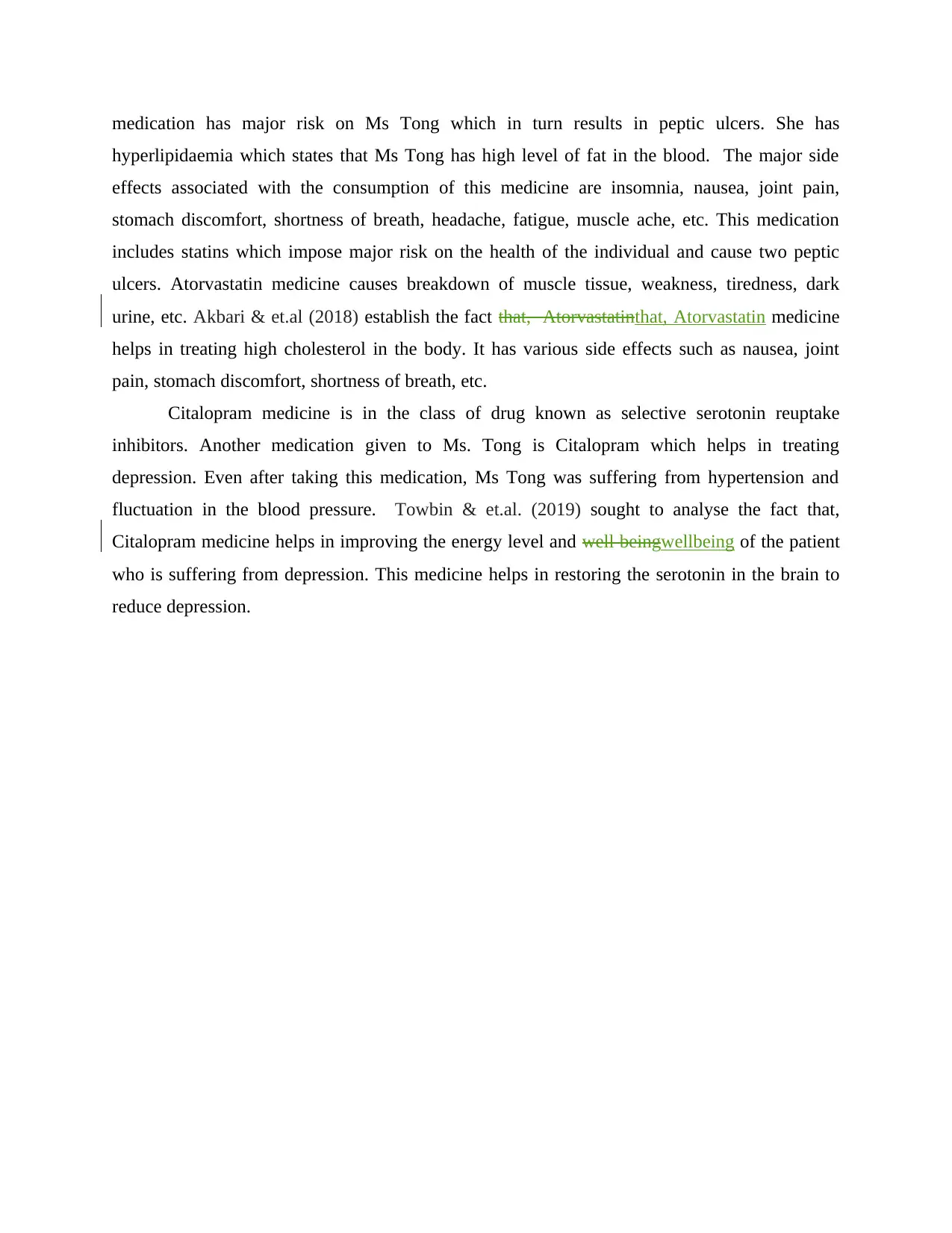
medication has major risk on Ms Tong which in turn results in peptic ulcers. She has
hyperlipidaemia which states that Ms Tong has high level of fat in the blood. The major side
effects associated with the consumption of this medicine are insomnia, nausea, joint pain,
stomach discomfort, shortness of breath, headache, fatigue, muscle ache, etc. This medication
includes statins which impose major risk on the health of the individual and cause two peptic
ulcers. Atorvastatin medicine causes breakdown of muscle tissue, weakness, tiredness, dark
urine, etc. Akbari & et.al (2018) establish the fact that, Atorvastatinthat, Atorvastatin medicine
helps in treating high cholesterol in the body. It has various side effects such as nausea, joint
pain, stomach discomfort, shortness of breath, etc.
Citalopram medicine is in the class of drug known as selective serotonin reuptake
inhibitors. Another medication given to Ms. Tong is Citalopram which helps in treating
depression. Even after taking this medication, Ms Tong was suffering from hypertension and
fluctuation in the blood pressure. Towbin & et.al. (2019) sought to analyse the fact that,
Citalopram medicine helps in improving the energy level and well beingwellbeing of the patient
who is suffering from depression. This medicine helps in restoring the serotonin in the brain to
reduce depression.
hyperlipidaemia which states that Ms Tong has high level of fat in the blood. The major side
effects associated with the consumption of this medicine are insomnia, nausea, joint pain,
stomach discomfort, shortness of breath, headache, fatigue, muscle ache, etc. This medication
includes statins which impose major risk on the health of the individual and cause two peptic
ulcers. Atorvastatin medicine causes breakdown of muscle tissue, weakness, tiredness, dark
urine, etc. Akbari & et.al (2018) establish the fact that, Atorvastatinthat, Atorvastatin medicine
helps in treating high cholesterol in the body. It has various side effects such as nausea, joint
pain, stomach discomfort, shortness of breath, etc.
Citalopram medicine is in the class of drug known as selective serotonin reuptake
inhibitors. Another medication given to Ms. Tong is Citalopram which helps in treating
depression. Even after taking this medication, Ms Tong was suffering from hypertension and
fluctuation in the blood pressure. Towbin & et.al. (2019) sought to analyse the fact that,
Citalopram medicine helps in improving the energy level and well beingwellbeing of the patient
who is suffering from depression. This medicine helps in restoring the serotonin in the brain to
reduce depression.
Paraphrase This Document
Need a fresh take? Get an instant paraphrase of this document with our AI Paraphraser
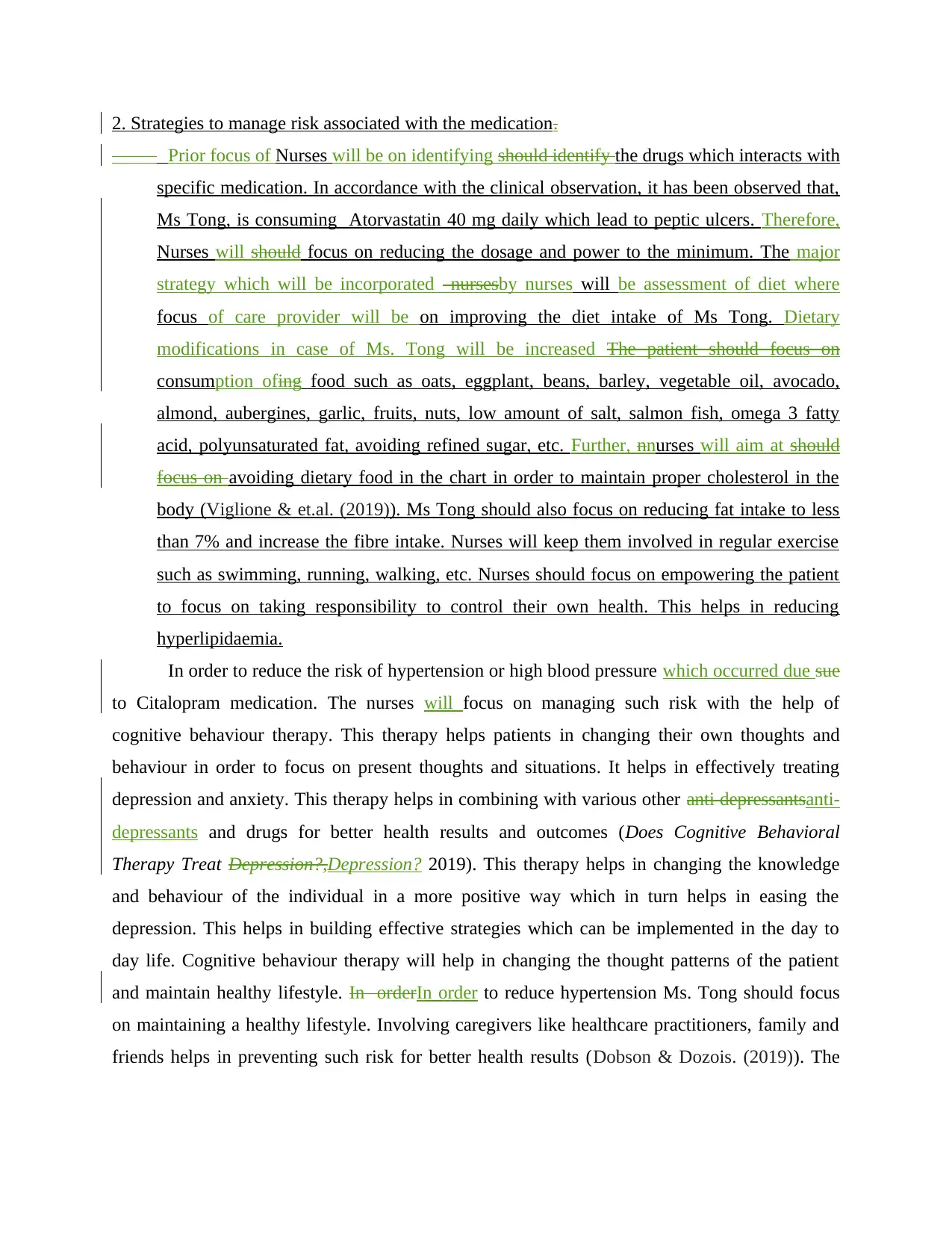
2. Strategies to manage risk associated with the medication.
Prior focus of Nurses will be on identifying should identify the drugs which interacts with
specific medication. In accordance with the clinical observation, it has been observed that,
Ms Tong, is consuming Atorvastatin 40 mg daily which lead to peptic ulcers. Therefore,
Nurses will should focus on reducing the dosage and power to the minimum. The major
strategy which will be incorporated nursesby nurses will be assessment of diet where
focus of care provider will be on improving the diet intake of Ms Tong. Dietary
modifications in case of Ms. Tong will be increased The patient should focus on
consumption ofing food such as oats, eggplant, beans, barley, vegetable oil, avocado,
almond, aubergines, garlic, fruits, nuts, low amount of salt, salmon fish, omega 3 fatty
acid, polyunsaturated fat, avoiding refined sugar, etc. Further, nnurses will aim at should
focus on avoiding dietary food in the chart in order to maintain proper cholesterol in the
body (Viglione & et.al. (2019)). Ms Tong should also focus on reducing fat intake to less
than 7% and increase the fibre intake. Nurses will keep them involved in regular exercise
such as swimming, running, walking, etc. Nurses should focus on empowering the patient
to focus on taking responsibility to control their own health. This helps in reducing
hyperlipidaemia.
In order to reduce the risk of hypertension or high blood pressure which occurred due sue
to Citalopram medication. The nurses will focus on managing such risk with the help of
cognitive behaviour therapy. This therapy helps patients in changing their own thoughts and
behaviour in order to focus on present thoughts and situations. It helps in effectively treating
depression and anxiety. This therapy helps in combining with various other anti depressantsanti-
depressants and drugs for better health results and outcomes (Does Cognitive Behavioral
Therapy Treat Depression?,Depression? 2019). This therapy helps in changing the knowledge
and behaviour of the individual in a more positive way which in turn helps in easing the
depression. This helps in building effective strategies which can be implemented in the day to
day life. Cognitive behaviour therapy will help in changing the thought patterns of the patient
and maintain healthy lifestyle. In orderIn order to reduce hypertension Ms. Tong should focus
on maintaining a healthy lifestyle. Involving caregivers like healthcare practitioners, family and
friends helps in preventing such risk for better health results (Dobson & Dozois. (2019)). The
Prior focus of Nurses will be on identifying should identify the drugs which interacts with
specific medication. In accordance with the clinical observation, it has been observed that,
Ms Tong, is consuming Atorvastatin 40 mg daily which lead to peptic ulcers. Therefore,
Nurses will should focus on reducing the dosage and power to the minimum. The major
strategy which will be incorporated nursesby nurses will be assessment of diet where
focus of care provider will be on improving the diet intake of Ms Tong. Dietary
modifications in case of Ms. Tong will be increased The patient should focus on
consumption ofing food such as oats, eggplant, beans, barley, vegetable oil, avocado,
almond, aubergines, garlic, fruits, nuts, low amount of salt, salmon fish, omega 3 fatty
acid, polyunsaturated fat, avoiding refined sugar, etc. Further, nnurses will aim at should
focus on avoiding dietary food in the chart in order to maintain proper cholesterol in the
body (Viglione & et.al. (2019)). Ms Tong should also focus on reducing fat intake to less
than 7% and increase the fibre intake. Nurses will keep them involved in regular exercise
such as swimming, running, walking, etc. Nurses should focus on empowering the patient
to focus on taking responsibility to control their own health. This helps in reducing
hyperlipidaemia.
In order to reduce the risk of hypertension or high blood pressure which occurred due sue
to Citalopram medication. The nurses will focus on managing such risk with the help of
cognitive behaviour therapy. This therapy helps patients in changing their own thoughts and
behaviour in order to focus on present thoughts and situations. It helps in effectively treating
depression and anxiety. This therapy helps in combining with various other anti depressantsanti-
depressants and drugs for better health results and outcomes (Does Cognitive Behavioral
Therapy Treat Depression?,Depression? 2019). This therapy helps in changing the knowledge
and behaviour of the individual in a more positive way which in turn helps in easing the
depression. This helps in building effective strategies which can be implemented in the day to
day life. Cognitive behaviour therapy will help in changing the thought patterns of the patient
and maintain healthy lifestyle. In orderIn order to reduce hypertension Ms. Tong should focus
on maintaining a healthy lifestyle. Involving caregivers like healthcare practitioners, family and
friends helps in preventing such risk for better health results (Dobson & Dozois. (2019)). The
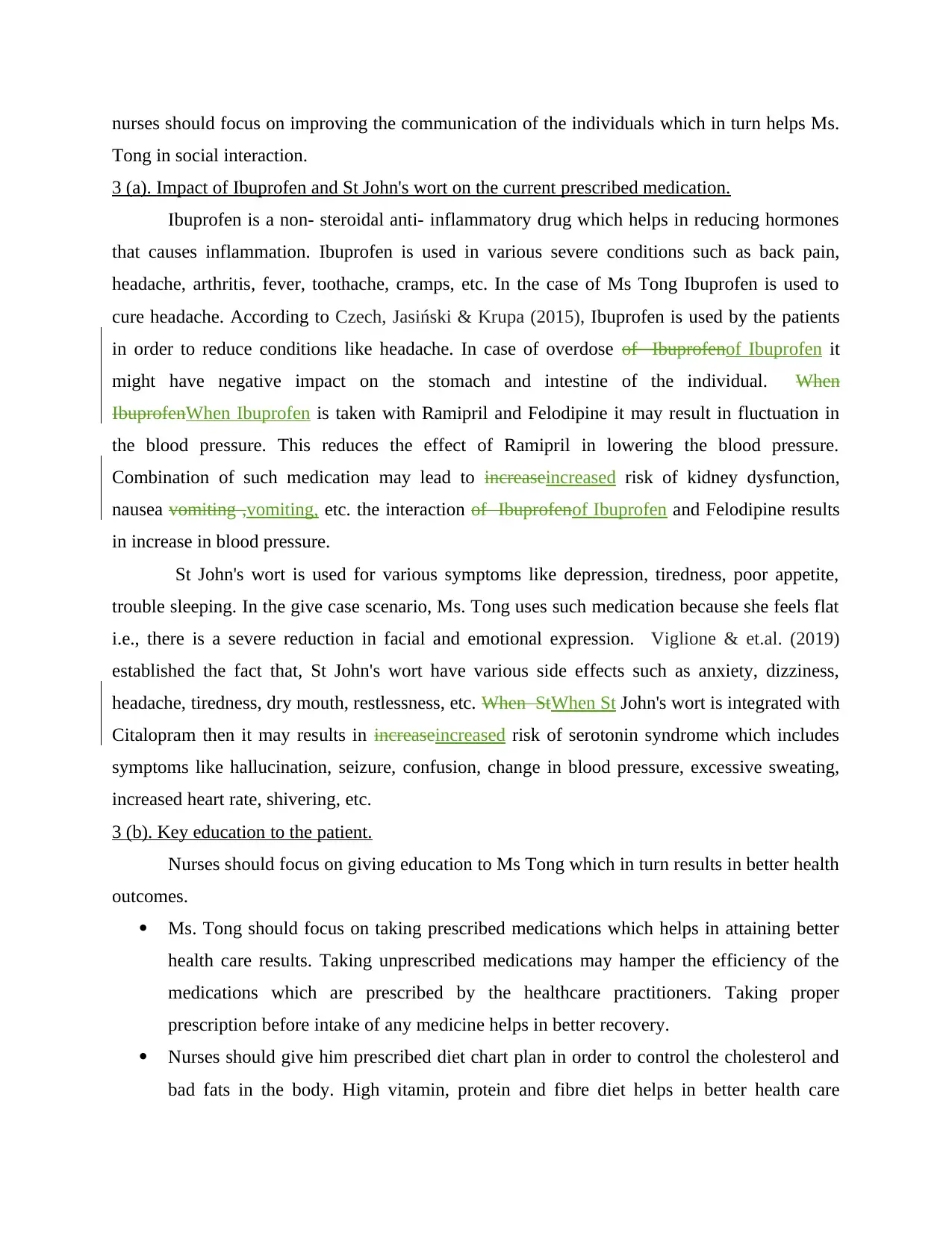
nurses should focus on improving the communication of the individuals which in turn helps Ms.
Tong in social interaction.
3 (a). Impact of Ibuprofen and St John's wort on the current prescribed medication.
Ibuprofen is a non- steroidal anti- inflammatory drug which helps in reducing hormones
that causes inflammation. Ibuprofen is used in various severe conditions such as back pain,
headache, arthritis, fever, toothache, cramps, etc. In the case of Ms Tong Ibuprofen is used to
cure headache. According to Czech, Jasiński & Krupa (2015), Ibuprofen is used by the patients
in order to reduce conditions like headache. In case of overdose of Ibuprofenof Ibuprofen it
might have negative impact on the stomach and intestine of the individual. When
IbuprofenWhen Ibuprofen is taken with Ramipril and Felodipine it may result in fluctuation in
the blood pressure. This reduces the effect of Ramipril in lowering the blood pressure.
Combination of such medication may lead to increaseincreased risk of kidney dysfunction,
nausea vomiting ,vomiting, etc. the interaction of Ibuprofenof Ibuprofen and Felodipine results
in increase in blood pressure.
St John's wort is used for various symptoms like depression, tiredness, poor appetite,
trouble sleeping. In the give case scenario, Ms. Tong uses such medication because she feels flat
i.e., there is a severe reduction in facial and emotional expression. Viglione & et.al. (2019)
established the fact that, St John's wort have various side effects such as anxiety, dizziness,
headache, tiredness, dry mouth, restlessness, etc. When StWhen St John's wort is integrated with
Citalopram then it may results in increaseincreased risk of serotonin syndrome which includes
symptoms like hallucination, seizure, confusion, change in blood pressure, excessive sweating,
increased heart rate, shivering, etc.
3 (b). Key education to the patient.
Nurses should focus on giving education to Ms Tong which in turn results in better health
outcomes.
Ms. Tong should focus on taking prescribed medications which helps in attaining better
health care results. Taking unprescribed medications may hamper the efficiency of the
medications which are prescribed by the healthcare practitioners. Taking proper
prescription before intake of any medicine helps in better recovery.
Nurses should give him prescribed diet chart plan in order to control the cholesterol and
bad fats in the body. High vitamin, protein and fibre diet helps in better health care
Tong in social interaction.
3 (a). Impact of Ibuprofen and St John's wort on the current prescribed medication.
Ibuprofen is a non- steroidal anti- inflammatory drug which helps in reducing hormones
that causes inflammation. Ibuprofen is used in various severe conditions such as back pain,
headache, arthritis, fever, toothache, cramps, etc. In the case of Ms Tong Ibuprofen is used to
cure headache. According to Czech, Jasiński & Krupa (2015), Ibuprofen is used by the patients
in order to reduce conditions like headache. In case of overdose of Ibuprofenof Ibuprofen it
might have negative impact on the stomach and intestine of the individual. When
IbuprofenWhen Ibuprofen is taken with Ramipril and Felodipine it may result in fluctuation in
the blood pressure. This reduces the effect of Ramipril in lowering the blood pressure.
Combination of such medication may lead to increaseincreased risk of kidney dysfunction,
nausea vomiting ,vomiting, etc. the interaction of Ibuprofenof Ibuprofen and Felodipine results
in increase in blood pressure.
St John's wort is used for various symptoms like depression, tiredness, poor appetite,
trouble sleeping. In the give case scenario, Ms. Tong uses such medication because she feels flat
i.e., there is a severe reduction in facial and emotional expression. Viglione & et.al. (2019)
established the fact that, St John's wort have various side effects such as anxiety, dizziness,
headache, tiredness, dry mouth, restlessness, etc. When StWhen St John's wort is integrated with
Citalopram then it may results in increaseincreased risk of serotonin syndrome which includes
symptoms like hallucination, seizure, confusion, change in blood pressure, excessive sweating,
increased heart rate, shivering, etc.
3 (b). Key education to the patient.
Nurses should focus on giving education to Ms Tong which in turn results in better health
outcomes.
Ms. Tong should focus on taking prescribed medications which helps in attaining better
health care results. Taking unprescribed medications may hamper the efficiency of the
medications which are prescribed by the healthcare practitioners. Taking proper
prescription before intake of any medicine helps in better recovery.
Nurses should give him prescribed diet chart plan in order to control the cholesterol and
bad fats in the body. High vitamin, protein and fibre diet helps in better health care
⊘ This is a preview!⊘
Do you want full access?
Subscribe today to unlock all pages.

Trusted by 1+ million students worldwide

outcomes. Patients with high blood pressure and cholesterol should avoid eating dietary
food, excess oil, refined sugar, junk food, etc.
Ms. Tong should get involved in physical activity to improve health outcomes of the
individual. Nurses should keep them involved in regular exercise such as swimming,
running, walking, etc.
Collaboration of caregivers and healthcare practitioners helps in reducing depression. Ms.
Tong should socialize with people and get involved in activity which inherit positive
attitude in individual. This will help Ms. Tong in expressing her thoughts and belief and
leads to reduction in depression.
Cognitive behaviour therapy helps patients in changing their own thoughts and behaviour
in order to manage anxiety and depression (Dobson & Dozois. (2019)). This therapy will
help in changing the thought patterns of the patient which in turn helps in maintaining
healthy lifestyle.
CONCLUSION
From the above study it has been concluded that, medication is an effective drug which
helps in treating various health problems and maintaining the well-being of an individual. This
study evaluates the risk associated with prescribed medications on the body. This study further
concludes the, nursing intervention to manage risk associated with the medication. This study
also concludes impact of Ibuprofen and St John's wort on the current prescribed medication.
Lastly, it also demonstrates key educational points to patients for better health outcomes.
food, excess oil, refined sugar, junk food, etc.
Ms. Tong should get involved in physical activity to improve health outcomes of the
individual. Nurses should keep them involved in regular exercise such as swimming,
running, walking, etc.
Collaboration of caregivers and healthcare practitioners helps in reducing depression. Ms.
Tong should socialize with people and get involved in activity which inherit positive
attitude in individual. This will help Ms. Tong in expressing her thoughts and belief and
leads to reduction in depression.
Cognitive behaviour therapy helps patients in changing their own thoughts and behaviour
in order to manage anxiety and depression (Dobson & Dozois. (2019)). This therapy will
help in changing the thought patterns of the patient which in turn helps in maintaining
healthy lifestyle.
CONCLUSION
From the above study it has been concluded that, medication is an effective drug which
helps in treating various health problems and maintaining the well-being of an individual. This
study evaluates the risk associated with prescribed medications on the body. This study further
concludes the, nursing intervention to manage risk associated with the medication. This study
also concludes impact of Ibuprofen and St John's wort on the current prescribed medication.
Lastly, it also demonstrates key educational points to patients for better health outcomes.
Paraphrase This Document
Need a fresh take? Get an instant paraphrase of this document with our AI Paraphraser
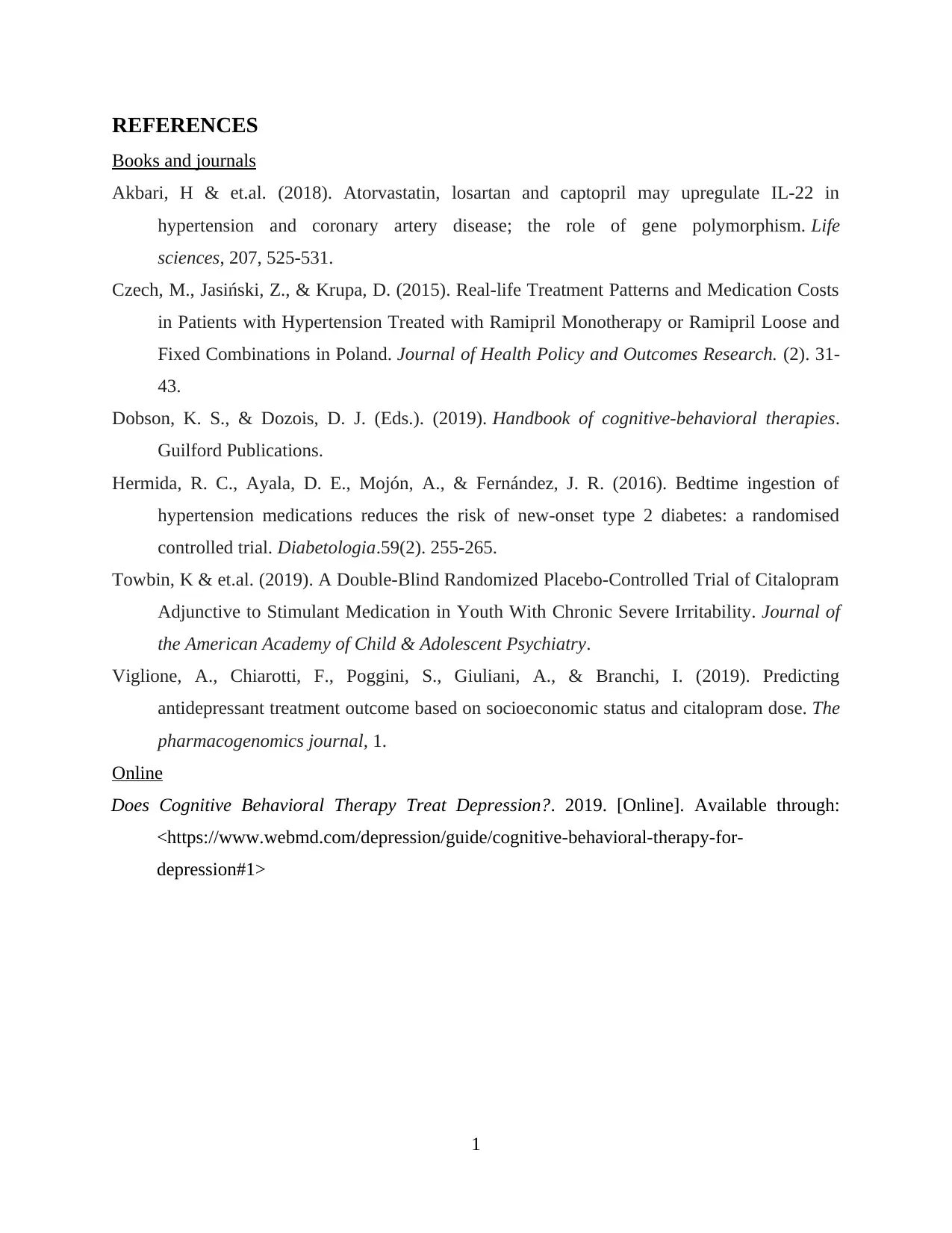
REFERENCES
Books and journals
Akbari, H & et.al. (2018). Atorvastatin, losartan and captopril may upregulate IL-22 in
hypertension and coronary artery disease; the role of gene polymorphism. Life
sciences, 207, 525-531.
Czech, M., Jasiński, Z., & Krupa, D. (2015). Real-life Treatment Patterns and Medication Costs
in Patients with Hypertension Treated with Ramipril Monotherapy or Ramipril Loose and
Fixed Combinations in Poland. Journal of Health Policy and Outcomes Research. (2). 31-
43.
Dobson, K. S., & Dozois, D. J. (Eds.). (2019). Handbook of cognitive-behavioral therapies.
Guilford Publications.
Hermida, R. C., Ayala, D. E., Mojón, A., & Fernández, J. R. (2016). Bedtime ingestion of
hypertension medications reduces the risk of new-onset type 2 diabetes: a randomised
controlled trial. Diabetologia.59(2). 255-265.
Towbin, K & et.al. (2019). A Double-Blind Randomized Placebo-Controlled Trial of Citalopram
Adjunctive to Stimulant Medication in Youth With Chronic Severe Irritability. Journal of
the American Academy of Child & Adolescent Psychiatry.
Viglione, A., Chiarotti, F., Poggini, S., Giuliani, A., & Branchi, I. (2019). Predicting
antidepressant treatment outcome based on socioeconomic status and citalopram dose. The
pharmacogenomics journal, 1.
Online
Does Cognitive Behavioral Therapy Treat Depression?. 2019. [Online]. Available through:
<https://www.webmd.com/depression/guide/cognitive-behavioral-therapy-for-
depression#1>
1
Books and journals
Akbari, H & et.al. (2018). Atorvastatin, losartan and captopril may upregulate IL-22 in
hypertension and coronary artery disease; the role of gene polymorphism. Life
sciences, 207, 525-531.
Czech, M., Jasiński, Z., & Krupa, D. (2015). Real-life Treatment Patterns and Medication Costs
in Patients with Hypertension Treated with Ramipril Monotherapy or Ramipril Loose and
Fixed Combinations in Poland. Journal of Health Policy and Outcomes Research. (2). 31-
43.
Dobson, K. S., & Dozois, D. J. (Eds.). (2019). Handbook of cognitive-behavioral therapies.
Guilford Publications.
Hermida, R. C., Ayala, D. E., Mojón, A., & Fernández, J. R. (2016). Bedtime ingestion of
hypertension medications reduces the risk of new-onset type 2 diabetes: a randomised
controlled trial. Diabetologia.59(2). 255-265.
Towbin, K & et.al. (2019). A Double-Blind Randomized Placebo-Controlled Trial of Citalopram
Adjunctive to Stimulant Medication in Youth With Chronic Severe Irritability. Journal of
the American Academy of Child & Adolescent Psychiatry.
Viglione, A., Chiarotti, F., Poggini, S., Giuliani, A., & Branchi, I. (2019). Predicting
antidepressant treatment outcome based on socioeconomic status and citalopram dose. The
pharmacogenomics journal, 1.
Online
Does Cognitive Behavioral Therapy Treat Depression?. 2019. [Online]. Available through:
<https://www.webmd.com/depression/guide/cognitive-behavioral-therapy-for-
depression#1>
1

2
⊘ This is a preview!⊘
Do you want full access?
Subscribe today to unlock all pages.

Trusted by 1+ million students worldwide
1 out of 9
Related Documents
Your All-in-One AI-Powered Toolkit for Academic Success.
+13062052269
info@desklib.com
Available 24*7 on WhatsApp / Email
![[object Object]](/_next/static/media/star-bottom.7253800d.svg)
Unlock your academic potential
Copyright © 2020–2025 A2Z Services. All Rights Reserved. Developed and managed by ZUCOL.





